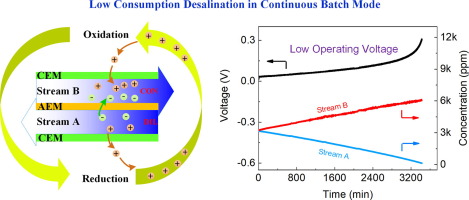RESEARCH
Low energy consumption and mechanism study of redox flow desalination
School of Physics and Telecommunication Engineering/Achievements 2021-02-22 15:08:17 From:School of Physics and Telecommunication Engineering Hits: Favorite
作者:Chen, FM (Chen, Fuming)[ 1 ] ; Wang, J (Wang, Jian)[ 1 ] ; Feng, CH (Feng, Chunhua)[ 2 ] ; Ma, JX (Ma, Jinxing)[ 3 ] ; Waite, TD (Waite, T. David)[ 3 ]
CHEMICAL ENGINEERING JOURNAL
卷:
文献号:
DOI:
出版年:
文献类型:Article
Low-energy desalination technologies capable of continuous throughput at reasonable operating and maintenance cost are now critically needed. Herein, we present a continuous desalination process with average energy consumption as low as 2.14 kJ mole(-1) salt removed achievable when using a 10 mM/10 mM ferri-/ferrocyanide solution that flows continuously between anode and cathode chambers. The salt feed at similar to 3000 ppm can be continuously desalted to a potable level of less than 150 ppm during the desalination process. At the anode, ferrocyanide is oxidized with electrons released to the external circuit and cations captured to achieve charge balance. Ferricyanide is reduced at the cathode, resulting in the constant transfer of anions from the dilute stream to the concentrate stream. The recycling of the redox mediators maintains an extremely low operating potential (similar to 100 mV) and continuous salt extraction with unlimited removal capacity. Comparison of the use of ferri-/ferrocyanide, pure ferricyanide and ferrocyanide solutions indicate that the ultra-low energy consumption can be ascribed to the excellent electrochemical properties of the ferri-/ferrocyanide couple and the extremely low overpotential of the redox reactions owing to the synergistic effect of sufficient simultaneous ferrocyanide oxidation and ferricyanide reduction in the flow electrolyte streams. Our research provides a route for ultra-low energy desalination based on voltage suppression via use of facile redox couple mediators.
关键词
作者关键词:Electrochemical desalination; Energy consumption; Redox couples; Water purification
KeyWords Plus:MEMBRANE CAPACITIVE DEIONIZATION; WATER DESALINATION; SEAWATER DESALINATION; INTERCALATION; PERFORMANCE; BRACKISH; COUPLE; CATION; SALT; ELECTRODES

Low energy consumption and mechanism study of redox flow desalination.pdf
